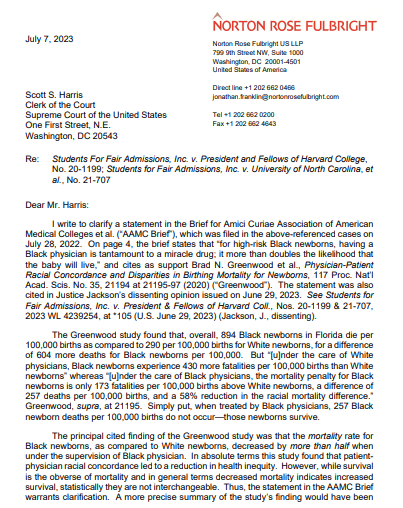Scientists and lawyers alike know that precision of language matters; a single word can result in a distinction that can shift the tone and meaning of an argument. Such appears to be the case with Supreme Court Justice Ketanji Brown Jackson’s recent dissent in “Students for Fair Admissions v. President and Fellows of Harvard College.” In it, she cited a claim about Black infant survival rates that a law firm behind an influential brief has moved to clarify. This instance frames a larger debate, and prompts recurring concerns surrounding the validation or verification of information used to support significant legal decisions, and what happens when critics say the math just doesn’t add up.


Norton Rose Fullbright, the firm in question responsible for the amicus curiae brief cited by Justice Jackson, filed a letter with the Supreme Court on Friday, seeking to clarify particular aspects of a study. The study has been the basis of a contentious point in Jackson’s dissent: that for high-risk Black newborns, having a Black physician more than doubles the chance of survival. This statement raised eyebrows and drew criticism due to perceived errors in mathematical logic that one might argue blur the scholarly rigor demanded of the Supreme Court.
Debate over the validity and usage of this claim emerged almost immediately. Plaintiffs’ litigator Ted Frank in Wallstreet Journal, questioned the very plausibility of Justice Jackson’s assertion. A key aspect that raised concerns was what he dubbed a mathematical impossibility. Criticizing the statistic, Frank argued that turning a 60% survival rate into a 120% rate is mathematically illogical, especially so when the actual survival rate noted significantly exceeds 99%. The assumption that such rates can be doubled, critics argue, leads to an unrealistic picture of the situation.
Contributing to the discoursing skepticism, George Washington University Law School scholar Jonathan Turley posited that these discrepancies result from a broadening tendency to use statistics and studies that the Court is unable to fact-check. This, he suggests, allows for decisions or dissents to hinge on highly contested factual assertions making it a matter of constitutional, and perhaps institutional concern.
In the clarification letter, Norton Rose Fullbright cautiously navigated these critiques— the discrepancy, they claim, emerges not from the study’s factual accuracy, but the imprecision in the translation of its findings into the dissent. The firm pointed out that mortality rates and survival rates, although seemly synergistic, are not statistically interchangeable. This, they assert, misrepresents the actual findings of the study originally conducted by Professor Brad Greenwood. The more astute characterization, they point out, would be that having a Black physician could reduce the likelihood of death for Black newborns compared to White newborns by over fifty percent.
Regardless, the firm’s clarification does little to address why Justice Jackson explicitly referred to Black newborns as “high-risk,” a term notably absent from Greenwood’s academic paper.
To examine such instances in isolation would detract from the broader implications they hold—where loopholes in the verification of facts dictate the direction of monumental legal decisions. The larger question posited here goes beyond the confines of any courtroom, touching on the broader discussion about the role of scholarship in policymaking, as well as how we vet and validate the crucial data that shapes it.
To conclude, while the clarification provided by Norton Rose Fullbright does offer some resolution, it simultaneously demonstrates a fundamental concern prevalent in judicial debates – the interpretation and usage of crucial data that often forms the anchor of many influential decisions made in the high echelons of the legal institutions. It forces us to confront the reality of statistical implications and the repercussions of their misinterpretations. For legal discourses to maintain credibility in their conviction and judgment, there is an urgent need for a more refined vetting system to keep check on the validity of studies and their critical interpretations.



